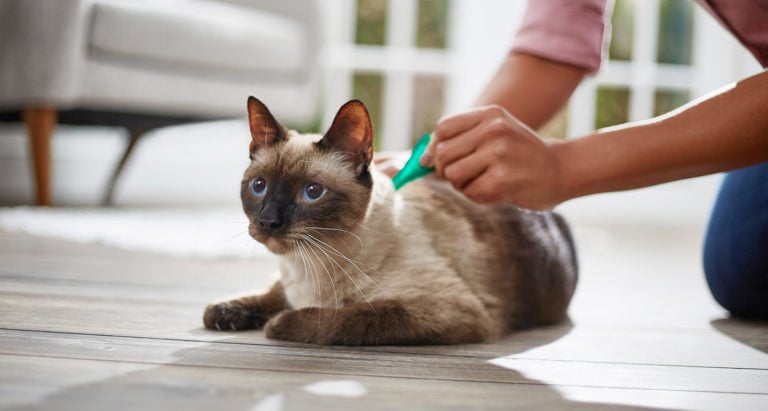Here’s a scary thought: The fleas your vet recently spotted on your dog or cat may only be the tip of the flea problem iceberg. Your home may also be the unfortunate site of a flea infestation.
When fleas are nipping at your ankles, a flea problem is more obvious. But in other cases, the signs of fleas in your house can be less apparent, especially if the infestation is still in its early stages.
So, what’s a pet parent to do? First things first: You need to learn how to detect fleas in your house. We spoke to vet experts on how to spot and get rid of the pesky buggers.
The 4-1-1 on Fleas

Fleas are considered small insects as well as ectoparasites. While fleas can be an issue year-round, they tend to be most common during the warmer months, so they are mostly seen in the spring and summer.
The Flea Life Cycle
Fleas have four life stages:
- Eggs are shed by a female flea
- The eggs hatch into flea larvae
- The larvae form pupae
- Adult fleas hatch from the pupae
Potential Problems Fleas Can Cause for Your Dog
Besides being annoying and kind of gross, fleas can pose a threat to your pets. For instance, if very young or older pets get infested with a large amount of fleas, it can result in anemia. Fleas can also transmit a parasite called tapeworms.
The best way to deal with fleas is to avoid them in the first place. Pet parents should use flea control products to keep fleas (and ticks) at bay and consult their veterinarian when choosing a flea prevention treatment.
But if you still find yourself with a potential pest problem, here’s how to spot fleas in your house before they get out of hand and how to get rid of fleas after they have made your home theirs.
How to Detect Fleas on Your Pet

Check their fur, especially around their head, neck and hindquarter, as these are the areas fleas usually target most.
Look for the following:
- Tiny, black, pepper-like specks: This is also called “flea dirt” or flea feces, and they are a telltale sign fleas are afoot. Grab a damp white paper towel or cloth and give those black dots a swipe. If the towel shows red streaks, it’s flea dirt.
- Reddened areas of skin with some fur loss: This can be caused by flea bites.
Find out more about what fleas look like.
If you do find fleas or signs of fleas, contact your vet right away to get their treatment recommendations.
How to Detect Fleas in Your Home

Check Pet Beds
Flea eggs don’t adhere to your pet’s fur as securely as the fleas themselves, so they tend to fall off in places your pet frequents.
Your pet’s bed should be the first place you look, as well as any other spots your pet is allowed to sleep, such as on couches, chairs or your own bed.
Flea eggs are tiny, off-white ovals that can be hard to see on light-colored upholstery and rugs. You may need to use a magnifying tool, like a magnifying glass or your phone’s magnification.
Look Over Carpeting
Capreting, area rugs and throw rugs are common places for fleas to lay eggs, so run your hands over these spaces carefully, looking in between the fibers for eggs.
Again, unless you have dark carpeting, they can be tough to spot, so look thoroughly with the aid of a magnifying glass.
Don’t Forget Hardwood Floors
Unfortunately, you’re not in the clear if your home has only bare, hardwood floors.
Determined fleas will lay eggs in the cracks between wood floorboards, giving them another place to grow and hide. Note that fleas can also reside along your baseboards.
Do the White Sock Test for Fleas
Put on knee-high (or at least calf-high) white socks and walk around your home for an afternoon, keeping close to carpeting and putting your feet up on furniture.
Then, check the socks for fleas. If they’ve taken up residence in your home, odds are that a few will be visible on your socks.
Flea Control: How to Get Rid of Fleas in Your Home

First, be sure you work with your veterinarian on the best way to treat and prevent fleas on your pet.
Because your dog already has fleas, you’ll need to treat them. Here’s how:
- Comb your dog with a flea comb.
- Bathe them with a flea shampoo.
- Treat them with a flea preventative, like Frontline Plus.
While dog fleas and cat fleas are often the same, it’s imperative that you only seek out a treatment (whether chewable, topical or collar) meant for your pet. Never use a product labeled for dogs on cats, as certain insecticides that are safe for dogs can be toxic to felines. Additionally, pay attention to the size of the dog that the flea preventative is intended for, as flea prevention meds are rarely one size fits all. The dose varies by weight. Always follow the directions on the package and your vet’s instructions.
Next, follow the home-cleaning steps below to gain the upper hand on the little buggers.
Launder Everything
Begin attacking your pest problem with a laundry day to end all laundry days.
- Wash everything that can be put into a washing machine. Your pet’s bed should be the first to go in, but also wash your own bedding, couch throws, bathroom mats, slipcovers and curtains.
- Use color-safe bleach.
- Use hot water. This can increase the chances all eggs and larvae will be destroyed.
Get Out the Vacuum
Vacuum and mop daily until you’re sure the pests have been eradicated. Because the egg-to-hatch life cycle can range anywhere from one to 10 days, per the CDC, keep up with your daily cleaning duties as needed.
Vacuuming tips and tricks:
- Use a flea collar: If you have a bag vacuum, buy an inexpensive flea collar, cut it into pieces and place them inside the bag. The fleas will be killed immediately upon entering the bag, so you don’t have to worry about them getting out if you get distracted and don’t throw out [the bag] right away.
- Don’t forget to clean the canister: And don’t forget to change the vacuum bag. Clean them extremely well because flea eggs can be quite hardy. You don’t want to give those pests an opportunity to make a comeback or worse, catch a free ride in your vacuum and set up shop in an area of the house previously unaffected by fleas.
Try a DIY Home Flea Treatment
Instead of opting for toxic foggers and flea bombs that professional pest control companies use, use a flea-busting carpet powder, like RX for Fleas Plus Fleabusters Powder, you can sprinkle the powder over carpets and furniture. Those aforementioned pro treatments should only be utilized in the most severe cases.
Don’t Neglect Your Yard
Fleas enter your home from the outside, so tackling your front and backyard with an outdoor flea spray, like Vet's Best Outdoor Flea & Tick Spray for Dogs, can help prevent future infestations.
Shop Related Products on Chewy
More on pesky fleas:
Share:

















